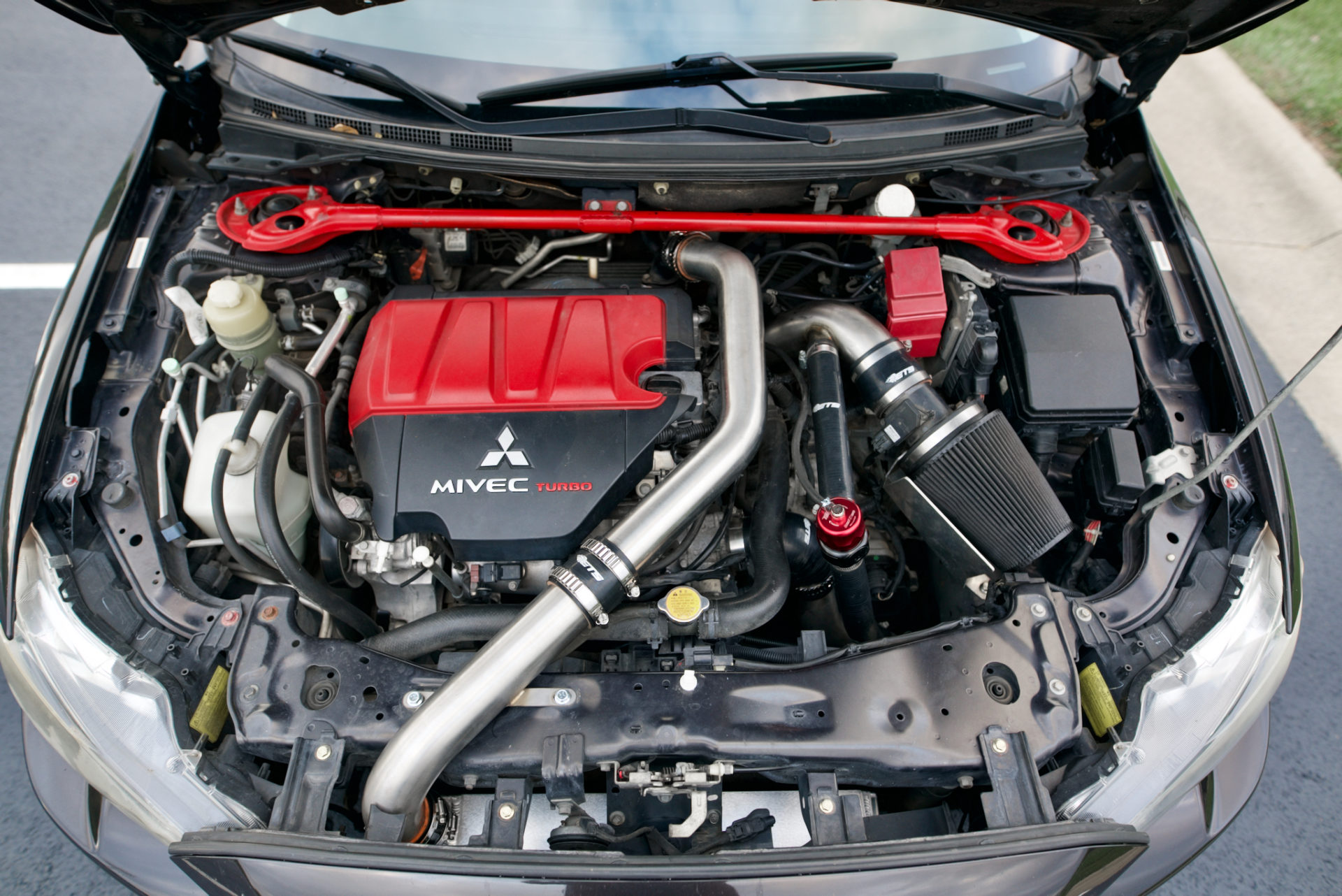On partial throttle, lower revs, my Evo X has turbocharger compressor surge. This is a phenomenon that occurs when the turbocharger compressor wheel is creating more air mass than the engine can ingest. This can happen in a variety of ways but the one most car folks are experienced with is when accelerating under boost and then getting off the throttle. Without a blow-off or bypass valve, the air between the turbo and closed throttle body has nowhere to go and the compressor tries to squeeze it until it can’t anymore. That air then comes back through the compressor wheel, making an audible choo-choo-choo noise in the process.
In certain situations (think large turbos and small engines), this can occur at full throttle. Under these high power situations, surge can easily damage turbo bearings due to the added thrust load going through the compressor wheel. A bad enough surge can even damage the blades of the compressor wheel!
Luckily, on my Evo X, this isn’t an issue, but surge does occur under partial throttle when there’s a pressure differential between the charge piping and intake manifold. It should be noted that even under lower loads, this can slowly cause wear on the turbocharger, but more importantly for me, it caused some funky driveability issues that manifested themselves as bucking and stuttering.

Two Problems.
Since I purchased the Evo X, I would occasionally find myself in surge at low rpm, low throttle angles, and having to drive around it. I was using the stock bypass valve, which is used by Mitsubishi as a safety switch in more ways than one. The valve works like any other BOV/bypass by opening at approximately 9-11 PSI of boost pressure differential. The second safety switch is that Mitsubishi integrated a bleed port from the charge pipe side of the valve to the side that attaches to a vacuum line. In other words, this helps control overboost by bleeding off excess boost pressure if it were to exceed what Mitsubishi intended. It’s a mechanical failsafe if something on the electric or pneumatic side stopped controlling the wastegate as intended.

To increase the boost pressure the OEM bypass valve can handle, it’s common to use an old-school DSM/Evo practice of crushing the top of the valve, effectively increasing spring seat pressure and making it a little harder for the bleed port effect to take place. What did this all mean for me in the end? As the OEM valve isn’t adjustable, I couldn’t tune it to get rid of the surge, and furthermore, if I ever wanted to increase boost, the stock bypass valve would bleed off some of that extra pressure!

This is where an adjustable BOV/bypass valve comes into play. As mentioned in the previous article, I use a Turbsosmart Dual Port BOV/bypass valve. The base setup has a spring rate and seat pressure that’s set to open at nearly the same point the OEM valve does. In addition, it has an adjustable cap to increase seat pressure, if desired, and it does this with much more precision than just crushing the top of an OEM valve. This increased seat pressure can come in handy when venting to the atmosphere while still running a mass airflow sensor, but I am not using it in that configuration. When set to open at factory rates, it performs exactly the same as the OEM valve, which meant when I switched to the Turbsosmart BOV, my compressor flutter problems weren’t immediately solved and some tuning and testing would have to occur.





7 comments
I guess the trick is to have the tension enough to prevent the BOV from opening so you don’t mess up your MAF readings during high vacuum periods.
Because I am running recirc and the BOV lines are all post MAF, I think it’s why my setup works well. I never have unmetered air and it’s open in most low load situations. At least that’s my working theory.
Makes sense.
Cutting a spring makes it stiffer so you probably increased the holding pressure of the BOV not reduced it
Cutting off coils does increase the spring rate, but the spring was (and still is to a much lesser degree) compressed by the cap, so seat pressure is reduced greatly.
Hello Daniel.
Would you mind sharing wich scan tool specifically and wich key fob you purchased.
I bought an MR last year and only have 1 smart key with it.. paranoia of loosing it is a lot.
Thanks man.
No problem!
This is the scan tool I used: https://www.amazon.com/gp/product/B07N69PC3D/ref=ppx_yo_dt_b_search_asin_title?ie=UTF8&psc=1
This is the fob:
https://www.amazon.com/gp/product/B07MQ1CDSV/ref=ppx_yo_dt_b_search_asin_title?ie=UTF8&psc=1
or these:
https://www.amazon.com/gp/product/B07GQ11WGG/ref=ppx_yo_dt_b_search_asin_title?ie=UTF8&psc=1
That being said, I could only get 1 fob and the valet key to program correctly at the same time. Every time I tried to do 2 fobs it wouldn’t work.